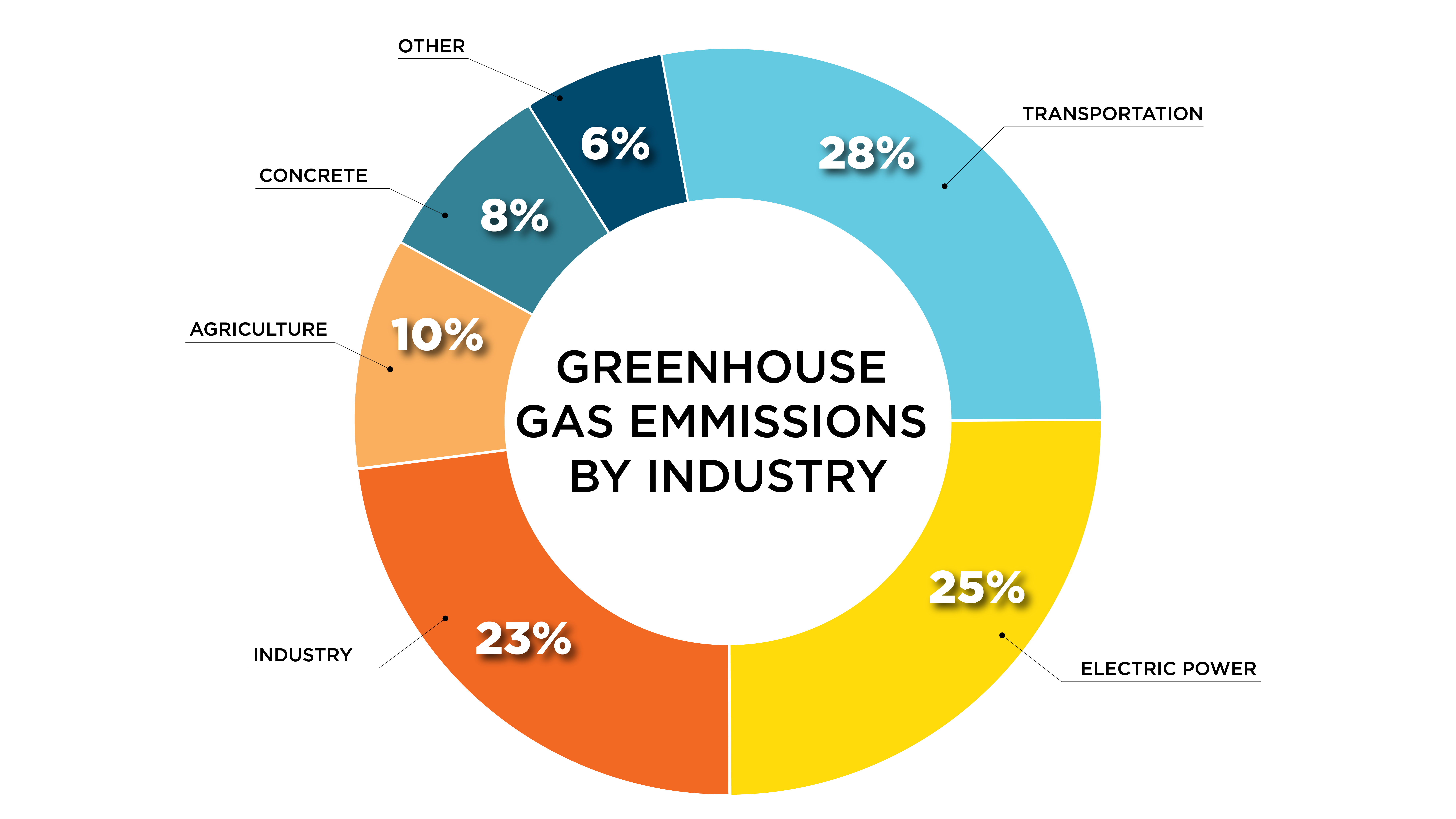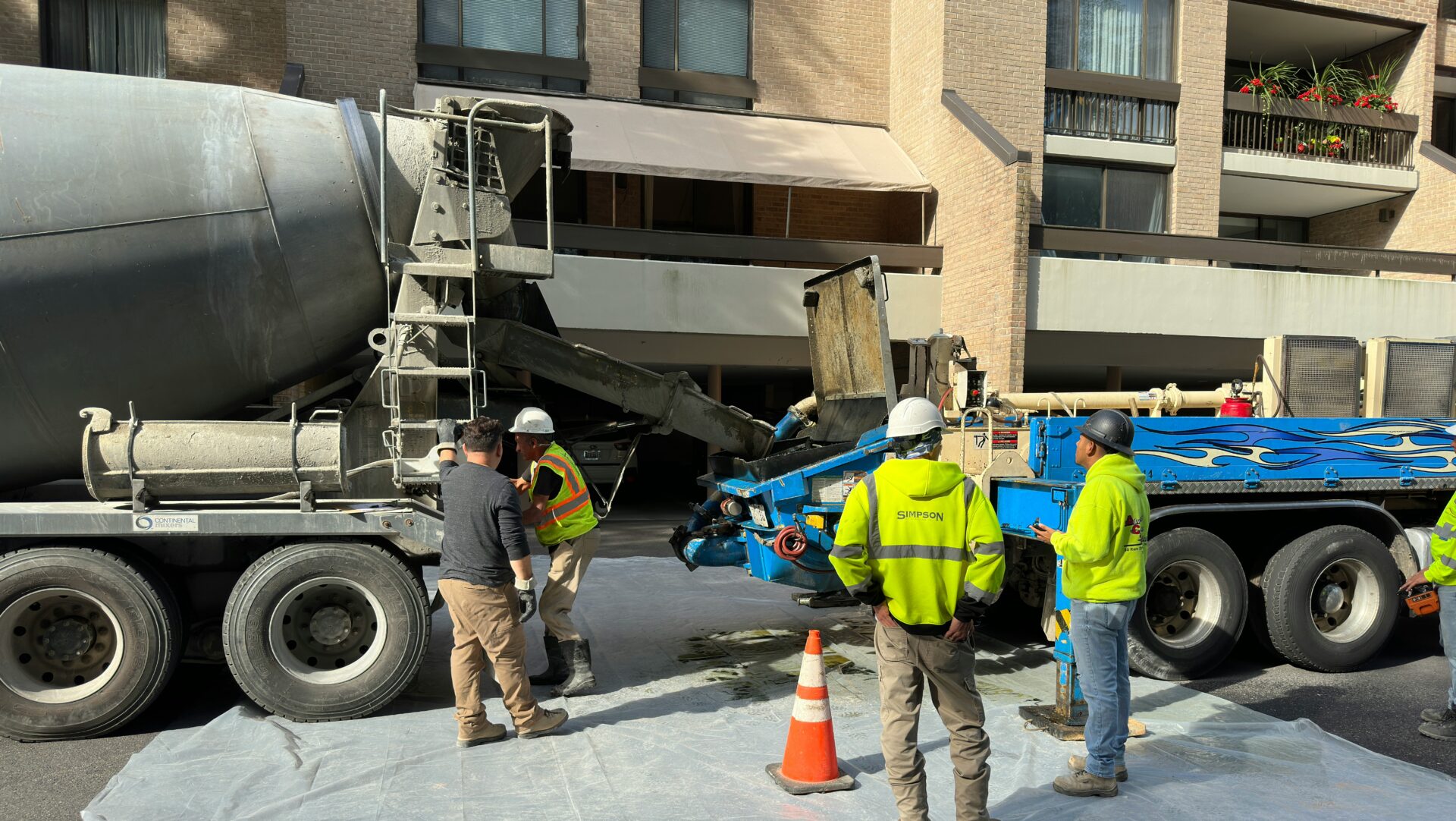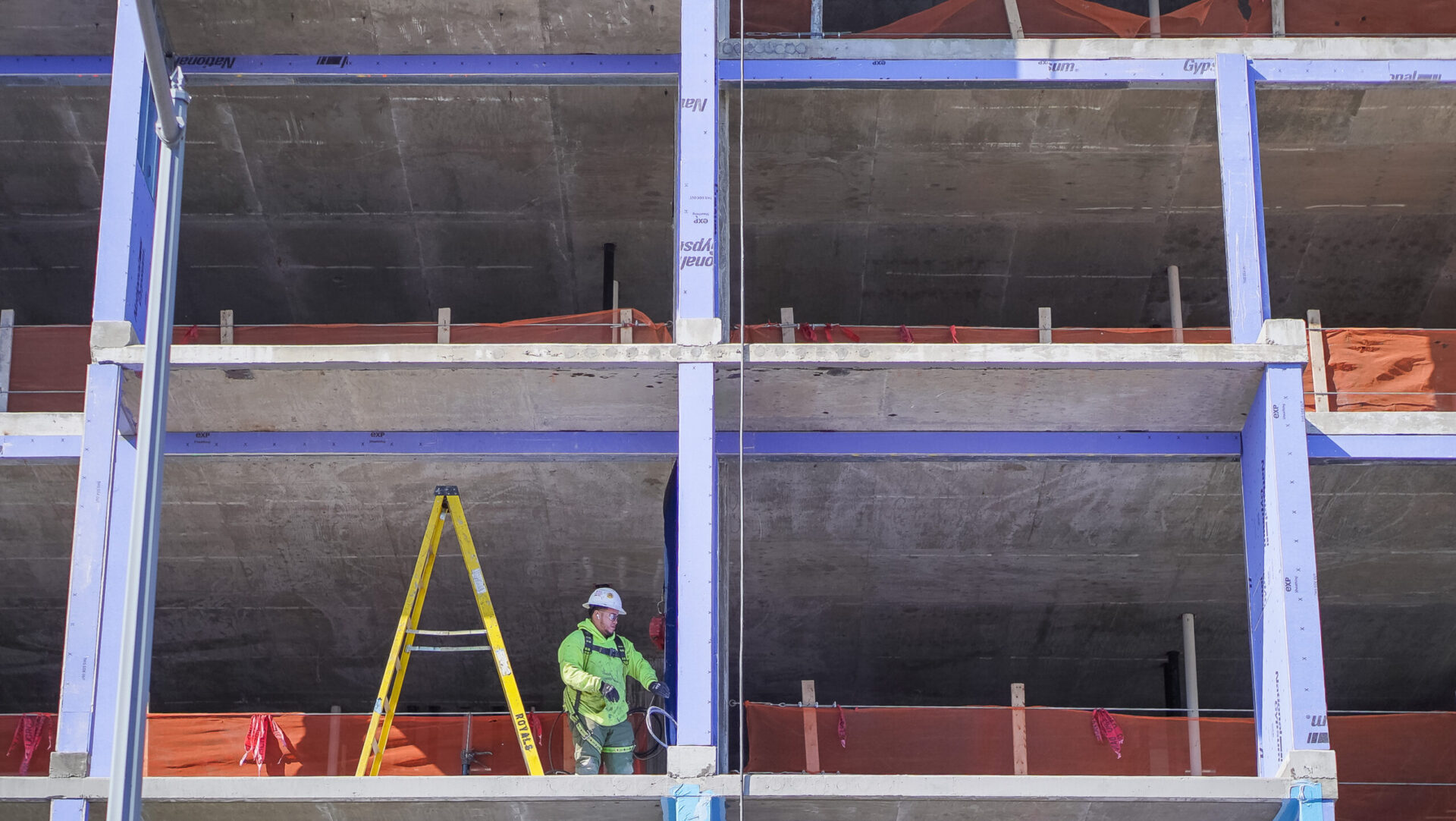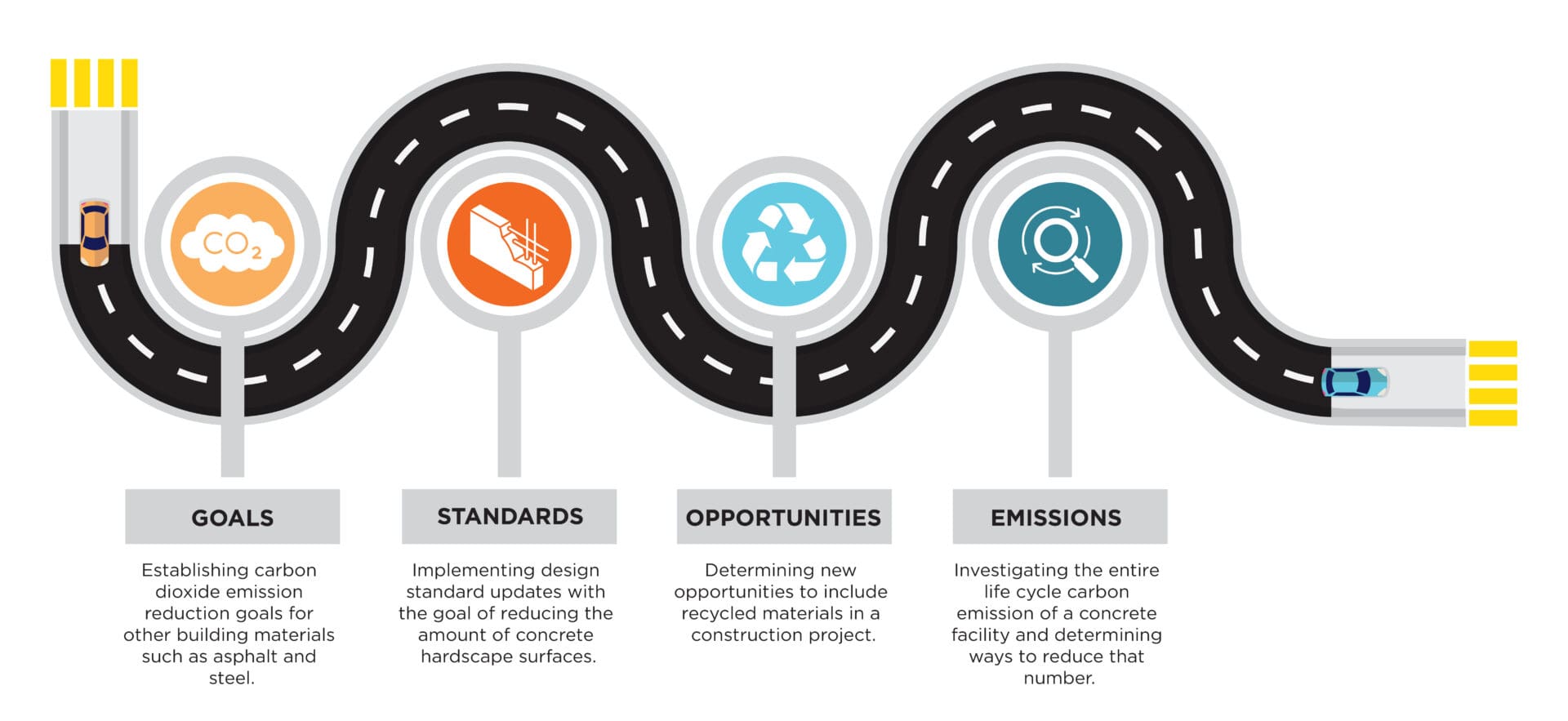July 23, 2025
Concrete is the most widely used construction material in the world—and one of the highest contributors to the global carbon dioxide emissions that accelerate climate change. For public agencies looking for more sustainable ways to construct roads, bridges, and sidewalks, low-carbon concrete offers a powerful opportunity to reduce emissions without sacrificing performance or durability. Read on to learn what low-carbon concrete is, why it matters, and how agencies can take practical steps to lead the way in building a lower-carbon future.
Concrete’s Contribution to Global Carbon Emissions
Concrete is one of the oldest human-made building materials, with some historians believing it predates pottery. At its most basic level, concrete is comprised of three ingredients: water, rock (aggregate), and cement. Cement comes in many varieties and is the source of the chemical reaction that makes concrete durable and strong. Modern concrete mixes also include additives to improve material characteristics, such as its viscosity, its curing time (how long it takes for the concrete to harden), and its total strength.
Despite growth in industries like computing and technology, concrete remains the second most consumed resource in the world, falling behind only water. Nearly 20 billion tons of concrete are produced each year and account for 8% of the world’s carbon dioxide emissions.

Nearly 20 billion tons of concrete are produced each year and account for 8% of the world’s carbon dioxide emissions.
From an environmental perspective, however, the production of cement is a destructive process. Limestone, which is mined from quarry, is the most common ingredient used in the production of cement. Once harvested, the limestone is ground into a fine powder and blended with other materials such as clay, shale, and iron ore. Next, the fine powder is fired in a large kiln at 2,700 degrees Fahrenheit to create a semi-molten byproduct, “clinker.” Finally, the clinker is pulverized into the finished product: cement powder. Each step of this cement manufacturing process requires significant energy and fossil fuels to execute. Energy consumption and burning of fossil fuels releases carbon molecules into the atmosphere, which trap heat and warms the environment, which accelerates climate change.
What Is Low-Carbon Concrete?
Global Warming Potential (GWP) is the unit of measurement used to determine how much pollution is generated in the production of a resource. GWP is measured in units of kilograms of carbon dioxide emissions generated. These GWP values are reported in an Environmental Product Declaration (EPD), which is a third-party-verified document that quantifies carbon dioxide emissions for building materials based on the best available scientific data.
The National Ready Mix Concrete Association (NRMCA) regularly publishes EPDs that establish the industry average GWP of concrete production across the United States (2023 report). The industry average GWP for concrete varies based on multiple factors, such as the concrete compressive strength and percentage of cement used. Concrete batch plants also produce EPDs for their many concrete products. While there is no universal definition, a low-carbon concrete is any mix design that has an EPD-identified GWP less than the industry average. Some agencies may define low-carbon concrete as a specific percent reduction in GWP when compared to the industry average at a specified compressive strength. For example, a low-carbon concrete may be a 4,000 psi mix design that produces 20 percent less GWP than the industry average 468.89 GWP per cubic yard.

Low-carbon concrete is comprised of the same ingredients as conventional concrete (water, aggregate, and cement), only in different quantities, meaning the finished product still has the same characteristics of strength and durability.
How Does Low-Carbon Concrete Work?
Since cement is concrete’s largest contributor to carbon dioxide emissions, the most common way to reduce concrete’s carbon footprint is by utilizing supplementary cementitious materials (SCMs). SCMs are materials that may be substituted for cement in a concrete mix design while providing similar strengthening chemical reaction properties. The most common SCM is fly ash, a natural byproduct of coal combustion in electric power production plants. By using SCMs, concrete mix designs will use lower volumes of cement, resulting in lower carbon dioxide emissions. It is worth noting that these SCMs also have their own affiliated GWPs, but they are comparatively lower than their cement counterparts. This results in a net reduction in GWP for a concrete mix design.
Low-carbon concrete is only in different quantities, meaning the finished product still has the same characteristics of strength and durability. The biggest drawback with low-carbon concrete is its longer cure time, meaning it might take the concrete longer to reach a desired strength when compared to conventional concrete. Thus, low-carbon concrete may not be desirable in applications where early strength is necessary.
How to Specify Low-Carbon Concrete on Your Project
What could it look like to reduce carbon emissions in the construction of your next transportation facility? Here are the fundamentals of specifying low-carbon concrete:
- Who: Reach out to regional concrete material suppliers. Ask if these suppliers can prepare EPDs for their concrete mixes and if they can provide any concrete products that reduce the volume of carbon dioxide emissions, including examples if possible.
- When: Ideally, project teams would involve concrete suppliers during the engineering and design phases of a project instead of waiting until construction begins. This proactive engagement increases the chance of success for both the owner and the supplier.
- What: Specify a carbon dioxide emission benchmark—for example, any concrete mix design that provides a carbon dioxide emission that is 10% less than the industry average—that is both attainable and readily available in the region. This percentage may be based on project complexity, cost, and overall volume of concrete.
- How: There are multiple ways to specify a low-carbon concrete material on a project. The simplest way is to provide an upper limit of carbon dioxide emissions for various concrete products. For example, you could ask for a 4,000 psi concrete mix design with 300 GWP or less. The contractor will submit an EPD provided by the concrete mix plant with a value that meets this benchmark, or the concrete mix will be rejected. This process is the simplest for the owner to implement, but it does not allow for complexities in specific work on a project or supply chain issues.
Regardless of the way you decide to specify low-carbon concrete, the most important part is taking that first step. If an owner never establishes a goal, they will never work towards reducing their carbon footprint. If a contractor fails to meet the specified benchmark, that still provides valuable information that you can use to refine your specifications on future projects.

When first launching a low-carbon concrete standard specification, consider starting off with a lower reduction percentage that feels attainable. An early success provides a strong foundation to build to higher reductions over time.
Additional Considerations
Here are a few more tips for the process, based on our experience working with public agencies to get low-carbon concrete into their projects:
- It’s okay to start small and build over time. When first launching a low-carbon concrete standard specification, consider starting off with a lower reduction percentage that feels attainable. An early success provides a strong foundation to build to higher reductions over time.
- If you’re not sure, try a pilot project! Pilot projects can help you gather valuable information before creating a standard specification. Sidewalk infill projects are prime candidates for pilot projects due to their lower overall risks and costs.
- There are some challenges outside a contractor’s control. Consider providing waivers to the benchmark due to project constraints and/or supply chain issues. This gives the contractor more flexibility, but the owner will have to make the determination on whether a waiver is justifiable. If too many waivers are issued on a project, then the reduction goal will not be met.
- You can specify a project-wide reduction goal rather than a concrete mix specific goal. For example, you could direct a contractor that the total volume of concrete used on a project may not exceed 10,000 GWP, as determined by submitted concrete mix EPD’s. This provides the contractor with more flexibility when constructing the project. For example, they may opt to use a higher strength concrete with a larger carbon footprint to construct a roundabout truck apron, and offset that larger carbon footprint with a very-low-carbon-footprint concrete in the sidewalks.
While the concept of low-carbon concrete is new for some, it’s reassuring to know there are private and public agencies across the country who have been specifying low-carbon concrete materials for years. Agencies do not have to be concerned about venturing into uncharted territory—others have already blazed the trail!

While establishing reduction benchmarks on construction projects is important, there are many other ways agencies can reduce their carbon footprint during project construction.
More Ways to Reduce Concrete Carbon Emissions in Transportation Projects
While establishing reduction benchmarks on construction projects is important, there are many other ways agencies can reduce their carbon footprint during project construction. These include:
- Establishing carbon dioxide emission reduction goals for other building materials such as asphalt and steel.
- Implementing design standard updates with the goal of reducing the amount of concrete hardscape surfaces.
- Determining new opportunities to include recycled materials in a construction project.
- Investigating the entire life cycle carbon emission of a concrete facility and determining ways to reduce that number. Currently, EPDs only consider the manufacturing process and do not consider construction, usage, or end of life of the facility.
The concrete industry is also looking at ways to reduce their carbon emissions around the globe. Multiple cement producers have invested in new production facilities that will be completely carbon neutral when they become operational. The first carbon-neutral cement production plant is slated to open before 2030.
Continue the Conversation
While there have been important strides taken to reduce the carbon footprint of concrete across the globe, there is always more work to be done. Public agencies have a unique opportunity—and responsibility—to lead by example to shape a more sustainable future. By specifying low-carbon concrete and rethinking traditional procurement practices, agencies can significantly reduce the environmental impact of infrastructure projects. These choices not only support broader sustainability goals but also demonstrate a commitment to innovation, resilience, and the well-being of future generations.
If you’d like to chat further about how we’ve worked with agencies who are leading the way in sustainable construction practices, reach out to start a conversation!
